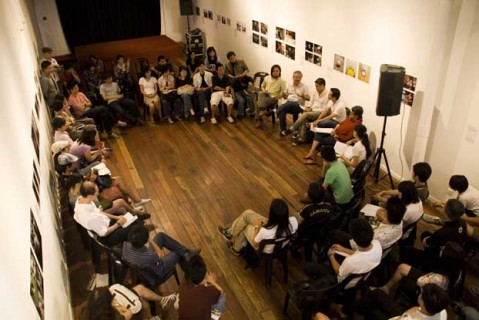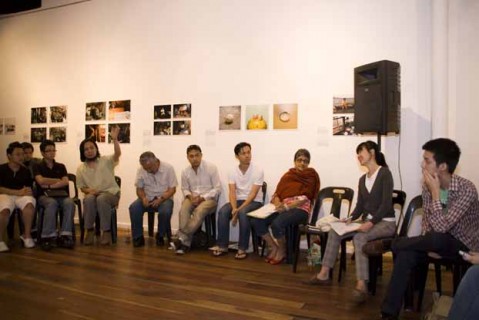


Design Circus Conversation #2
30 May 2009
Annexe Gallery
As people shuffled quietly into their seats, I had a quick glimpse around the room and I had to confess we had more present than I had expected. Forums are rarely filled up unless Farish Noor is giving the talk, a facilitator of the event joked. The theme for Designcircus Conversations 2 was ‘Being a contemporary designer in today’s modern world and design education’, in a time of economical recession are we creating the designers we need for today? We had invited four panellists ranging from educators and industrial practitioners to shed light on this matter.
We began by addressing implications and queries about the shifts of the creative industry within the last 20 years. Beyond the obvious advancement of technology, there’ve been prominent shifts in the interest, in the volume of activity, the options and quality specifically in design. Yet even though design has enjoyed an exponential amount of growth and revenue for colleges through the rising number of enrolments, there are complaints design schools are churning out too many graduates yearly, many without a grasp of general knowledge, language and understanding that design breathes further beyond the formalities of aesthetics and technical skill sets.
With this our attention shifted to the standards and involvement of MQA/LAN representatives who tentatively decide ‘what is education, what is training and who is qualified to teach?’ Yet there are few who haven’t been formally educated but these few exceptions are able to supervise or teach. An example of these stigmatic policies reveals educational institutions are told by LAN not to hire individuals who have the experience of practising art or design for decades as they do not have paper qualifications that certify their formalities and legitimacy of practise. The system has been created in such a manner to teach a class of diploma students, one must wield a degree, and to lecture for a class of degree students one most posses a master qualification, always one class in front. What then are the real basis on which they make these policies? Would this absurdness signify many of Malaysia’s renowned art practitioners such as Pak Hamzah or Ramli Ibrahim are unfit to teach in education institutions. But arguments on the flipside, say not all experienced practitioners are able to teach, therefore is LAN balancing this equation? After all in their interest, allowing any individual who has experience would mean the diminishing value of certification and education.

Yet ironically with all this discourse about the certification, many in the industry have little interest in post-graduate qualifications nowadays, as some graduates claim it as a passport, which they wave frantically at interviews in faith of guaranteeing a job. Many have confessed never using their degrees for job interviews, and if this rumour is deemed true, what then does it reveal about the depreciating values of our degrees and of education respectively? Some employers in the industry are refusing to hire passport graduates and are turning to those who haven’t even enrolled into art/design schools, complaints that graduates are robotically technical and the industry yeans for thinkers instead.
Which brings us to the importance of culture and humanities subjects in design schools. There is an increasing concern about the gap of knowledge in students who enrol in schools who lack a sense of historical, political and social awareness. Therefore to curb this dilemma there should be a strong urgency for a larger cultural awareness and appreciation, after all how can we begin to comprehend and design for culture when we don’t embrace and live in it? A panellist shares her philosophy that thinking about anything seriously is really her only aim. Students as people in society need to make the change. Students need to take power. They need to take that power back from the finance department, but it is not an easy process. A need for a strong action of complaints and letters is need, maybe even demonstrations, as one panellist emphasizes the need to ‘mogok’ and even hunger strike maybe. Yet this issue of local ignorance isn’t a special case for designers alone, our creative industry of film, music, visual and performance arts have equally been tainted for many years.
So then is our design schools a reflection of our industry? As this vicious cycle of blaming is a convenient practise in Malaysia, design has never been for other designers, but for the public. Yet our industry and educational institutions are created in a manner where they continue to only speak to themselves, then where does that leave the future of graduates? As the forum comes to a close, panellists leave with parting words of wisdom, to create smaller initiatives.
Design Circus Conversations #2 was facilitated by Sau Bin and Patricia , and our four panellist were Mr Toh, co-founder of PJCAD, runs his own interior firm, Douglas Lam a senior art director for an advertising firm, Joseph Foo a co-founder of 3nity designs and lecturer of 12 years and Marion D’Cruz a dancer, choreographer, teacher and a co-founder of Five Arts Centre.
~
Norman Teh is a co-founder of Design Circus, a collective of design enthusiasts with a shared passion and curiosity concerning design, which has also organized a series of workshops, small talks and design trips in South East Asia for students, researchers, educators and practitioners. Not interested in making a corporate career in agencies, he currently works as an Art Director for Bright Lights At Midnight (BLAM). Within the last couple of years he has worked with a variety of clients from Amir Muhammad, Nike, 8TV, Digi, Annexe Gallery, Five Arts Centre and many more.
Sorry, the comment form is closed at this time.
interesting article, when is the next one?
The point I like to make over and over and over again:
1800s : world population is estimated at 1 billion
2009: world population is estimated at 6.7 billion
People who worry or complain about drops in standards of education should consider a teaching career. Our schools are usually overcrowded.
That’s a great thought. But, Be optimistic more on the social fact. Those ugly facts you mentioned can be an opportunity for the individualistic designer to transform him/herself. That’s how your circus turn up and todays you all success…Cheers!